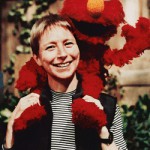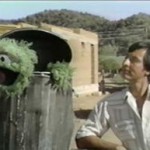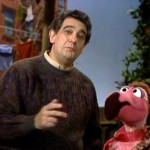Sometimes, writing a biography can send you on a social scavenger hunt. That’s how I discovered Judy Freudberg, a longtime Sesame Street writer who died on Monday at the age of 63. 
Judy Freudberg worked at Sesame Street for nearly forty years – from 1971 to 2010. She began as a production assistant, then became a Sesame writer in 1975, going on to write countless Muppet sketches, Sesame’s anniversary special 20 And Still Counting and many segments of “Elmo’s World”, of which she was head writer. Outside of the Muppets, she and Tony Geiss co-wrote the Steven Spielberg animated movies A Land Before Time and An American Tail.
I interviewed Freudberg for the Richard Hunt biography in August 2010, at a Greek diner near Manhattan’s Columbus Circle. She looked classy and casual, cheerful and quick to laugh. She had a Peter Pan youthfulness despite having just turned 60. Here are excerpts from our talk.
I discovered Freudberg and her work through a social scavenger hunt. I was looking for Charles Gibson, a Sesame script typist in the 70s, and an “on-again, off-again” lover of Richard Hunt. Their mutual friend, Gay Metropolis author Charles Kaiser, suggested Freudberg as someone who could find him. But rather than name her directly, Kaiser wrote: “His closest friend on the show was a woman who wrote for it, and may have co-written the first or second muppet movie.”
This sent me to the Muppet Wiki. Of the 160 Muppet writers listed, 29 are women, 11 of whom wrote for Sesame. Both the first and second Muppet movies (“The Muppet Movie” and “The Great Muppet Caper” respectively) were written by men. Could Kaiser have meant the first Sesame movie? “Follow That Bird” (1985) was co-written by Tony Geiss and Judy Freudberg, who also wrote for Sesame. I checked back with Kaiser; sure enough, he meant Freudberg.
We never did find Gibson. But by then, I was impressed by Freudberg herself.
 In addition to her many years at Sesame Street, I am particularly excited that Freudberg co-wrote An American Tail. Years before I read Rivington Street, Beyond the Pale or World of Our Fathers – or Maus, for that matter – An American Tail gave me the story of my ancestors.
In addition to her many years at Sesame Street, I am particularly excited that Freudberg co-wrote An American Tail. Years before I read Rivington Street, Beyond the Pale or World of Our Fathers – or Maus, for that matter – An American Tail gave me the story of my ancestors.
—
JMS: When did you start at Sesame Street?
JF: Richard [Hunt] and I actually started the same year. I remember meeting him, and we were both new. I started in the fall of ’71. I started writing in ’75.
JMS: Can you talk about being a writer on Sesame Street? I’m trying to puzzle out how characters come together. I know with the Two-Headed Monster, the writers were just hanging around, and Richard and Jerry [Nelson] were just playing around. That’s the story Jerry tells.
JF: It’s a good story, but Sara Compton first wrote the Two-Headed Monster. She called him Frank and Stein. Unless she was there and saw them playing around. But I know she was the first one, and I thought she came up with it. 
JMS: So would you say that was a typical story in how characters are created?
JF: It varies. Sometimes a writer will, on his or her own, come up with something. Norman Stiles, a writer, came up with the Count. Then when Jerry [Nelson] plays him, he becomes the Count. You write it, and whoever does it can either make it or break it. The performer brings a whole lot to it.
But other times we’re told we need a character. Like Abby Cadabby, we were told they wanted a pink girl monster. Instead, Tony Geiss came up with a girl fairy. But it varies. Maybe 9 times out of 10 a writer turns in something with a character.
JMS: It sounds like each contributor brings their own layer to it.
JF: Lots of layers. Which I think is why it was always so good, to have all those layers. It’s not so different from other shows; they just don’t have the puppets. You have someone creating a character, and it depends on who’s playing that character. But then you have the puppet design – that makes all the difference in the world too.
You know, Richard didn’t have speaking parts for many years. He was right hands, and then he was Sully, but Sully didn’t talk. The legend [is] of Richard finally getting a character, but the character didn’t speak.
JMS: He must not have been very happy about that!
JF: No. But then the speaking roles began, very shortly after that. If there was even a season between them, who knows. 
JMS: He had some great characters. Something like Gladys the Cow, how do you come up with such a character?
JF: I’m sure somebody wrote a cow, and then Richard did what he did with her, and then everybody wanted to write for her. That’s how things happened sometimes. An Anything Muppet character comes up, and everybody likes the character, so everybody starts writing for it more.
Then there was Radon. I think that’s what Richard called her. She was also an Anything Muppet. When the camera wasn’t running he used to do all sorts of funny things with her. Richard was hilarious on the set. Just crazy, wild and crazy funny.
JMS: Do you remember Leo the Party Monster at all? He’s got this one sketch, “The Party Line,” I’m curious about how that came about.
JF: Somebody wrote it.
JMS: It’s not for kids.
JF: It’s always for both. It’s always for kids and for adults. That was always the whole point of Sesame Street.
JMS: There’s so much more to read into it.
JF: Always.
JMS: Do you have early memories of writing for Sesame Street? 
JF: The first season I was writing, I got to write an episode for New Mexico. That was the first remote shoot they did, around ’75. It was just great. The reason – you always had to have a reason to go – and one of Luis’ relatives needed his house fixed, so they all went to the pueblo in Taos to help him. That’s where they met Buffy Sainte-Marie, and the first time we started using Buffy, I think. She was friends with Maria?
Then when we went to Hawaii a couple of years later, the whole point was to go visit Buffy. And Snuffleupagus wanted to go because he’s from Hawaii, so they had to find the famous Mount Snuffleupagus. So there were two plot lines going on at the same time. At that point, none of the adults knew Snuffy was real. They all thought he was imaginary.
That was when we were still doing bits. They didn’t have to be related. We had this plot line, but within the plot line, we could do anything we wanted, with Hawaii.
JMS: Like Mr. Hooper surfing. How do you come up with that?
JF: That’s funny. That’s the way it was. Jon Stone — the sense of humor, the style, everything, I think, comes from him. Mr. Hooper surfing. [laughs]
JMS: How does that come about? Somebody just thinks of that?
JF: Sure. Yeah. That was always so great. You could just write something. It’s changed a lot, but in the past, if you wrote something, the producers would go, “Oh wow, how can we do this?” if it were something difficult. Today they go, “Oh no, how can we do that?” It’s very different.
It’s gotten more complicated anyway. Production is more complicated than it used to be. Once you started doing all this bluescreen, it’s hard to go back to the way we used to do it. Much more time-consuming and expensive, but it looks fantastic.
When we first did “Elmo’s World,” and we wrote the active Elmos, which is the stuff at the end, Dorothy imagines Elmo doing whatever, it was beyond our wildest imaginations what they did with it, when they put it all in bluescreen like that. It always blew me away, what Kevin [Clash] did with them. My mouth would drop every time, and I’ve been there a long time!
Have you met with Kevin? Let him tell you the Elmo story with Richard.
JMS: There are a few different versions of the story, but the one that seems to be legend is Richard being a mentor and passing on the puppet.
JF: The way Kevin tells it is that Richard came into the room and said, “I hate doing these sweet characters,” and he threw Elmo at him. “You do him!” Kevin would tell you, it took him a while to find the character.
JMS: In the Muppet fan community there’s…
JF: I know, a split. Someone said that we jumped the shark with Elmo.
A lot of people have it wrong, and thought he was supposed to replace Grover. Which was never, ever the case, because you can’t replace Grover. 
JMS: Tell me about writing 20 and Still Counting. I love the two Placidos.
JF: Tony [Geiss] and I wrote 20 and Still Counting. We just thought, Why not? You always want celebrities in the special. We thought, How great! I don’t remember how the two Placidos came about. Joe Raposo wrote a special song for that.
That was another great thing about Sesame Street, that nobody was doing a kiddie show. The songs were great, and had sophistication to them. Joe created a style in the beginning. They don’t have that anymore. But for a long time, there was the Sesame Street sound.
JMS: Do you have thoughts on how Sesame Street has changed over the years?
JF: It’s changed in so many ways. It’s been 42 years. We went through many incarnations even to get to where it is now. I just left the show in February.
When Sesame Street first started, it was the only game in town. So they could get away with a lot more. They weren’t worried about competition.
And then we were told, around Season 30, 12 years ago, that we were losing our audience, especially with about 20 to 30 minutes left in the show. We were the only hourlong program on, children’s television was almost all 30-minute shows, and that’s when we came up with “Elmo’s World,” to go in the last part of the show, to win back their attention. And it worked.
But then we had to still play with the other part of the show, and that’s when we started playing with putting the street story together rather than having it spread out. Now they have a bunch of blocks. They think of it as the Sesame hour. They have the street story, another formatted piece, Abby’s Flying Fairy School, and then they alternate some Bert and Ernie animation with Murray going to school, and then Elmo’s World. So it’s four blocks. They have some letter and number films thrown in there, a couple of Muppet bits. There are hardly any Muppet bits anymore.
Mainly they keep saying it’s because how kids watch the show has changed. It was always meant to be watched with adults, and now fewer adults, we’re told, watch with their kids, so they want something that will hold the kid glued there for an hour. I was always morally opposed to that. Especially if you were doing something educational.
JMS: Speaking of the Muppets, so you and Richard were friends?
JF: We were friendly. We weren’t close. I remember going to his house in New Jersey once, he had a party. He and Victor [DiNapoli, a Sesame set designer] were friends, sometimes a group of us would do stuff together. I remember hanging out at Victor’s place one night. And there was this guy Chuck Gibson.
JMS: I’m trying to find him.
JF: We’re all trying to find him. I don’t know if he’s still alive. But Chuck and I were really good friends, and he and Richard became friends too. I remember one Christmas Day in the late 80s, Richard called me looking for Chuck. Chuck had already left New York. We talked for about an hour. I couldn’t help him. But we were both always looking for Chuck.
Richard was just always very funny, just a lot of fun, and funny to be around. One of those crazy funny people.
JMS: People think of Sesame Street and the gay world as being very separate, but it sounds like there was a lot of overlap.
JF: Well, kind of. I’m gay too, so it’s hard for me to… When I came out, so did Richard. We didn’t start out working there as gay. We didn’t know it right away. We both came out there, as far as I know.
JMS: So you did come out at Sesame Street at some point?
JF: I did. I came out to my friends there. It was one of those things that everybody slowly figured out, even if I didn’t tell everybody. I didn’t make an announcement. Nobody made an announcement. It just sort of happened.
I remember he and Chuck, when they got involved, just as friends, but they had a sexual relationship, and Chuck was definitely out. From the beginning. There was a group of guys at the workshop who were gay, and everybody knew they were gay.
JMS: What was the atmosphere at Sesame Street like, in terms of that?
JF: The atmosphere at Sesame Street was just like any other atmosphere back then. It was not comfortable to be out. These guys were, a few of them, sort of. It was just like anyplace else – it was the beginning of gay rights, but not yet, it wasn’t. It became more and more comfortable.
Now whether these two worlds can coexist – all these worlds coexist, so I don’t know how much one had to do with the other.
Everyone jokes about Bert and Ernie, saying that they’re not gay. I would say they’re not anatomically correct. Just very good friends. But they were created – not before Stonewall, because Stonewall and Sesame Street happened the same year – but when they first were doing Bert and Ernie, they were the odd couple, and that’s where it came from. Not from the gay world at all.
JMS: It’s funny the way things have changed, you almost can’t get away with that. It’s like we’ve lost the room for them to just be male friends, without making them gay.
JF: Well, they could be gay, but just not with each other! [laughs]
———
I regret that I didn’t get a chance to ask Freudberg about An American Tail.
And, for the record, I’m still looking for Charles Gibson.

Pingback: Judy Freudberg, Who Wrote for ‘Sesame Street,’ Dies at 62 | Literature Digest
Pingback: Judy Freudberg, Who Wrote for ‘Sesame Street,’ Dies at 62 | News of Life and Death
Excellent interview. What a loss. And really highlights the importance of telling the invisible story of gayness and Sesame.
What a lovely interview. She seems like an honest, yet completely tactful, person. I will pay more attention to the credits the next time I watch any of her works. Land Before Time always makes me cry! She will be missed.
Nice, Max. I always enjoyed it when Judy would show up on set. Her smile never failed to light up the place. I hope her leaving was gentle and easy. jn